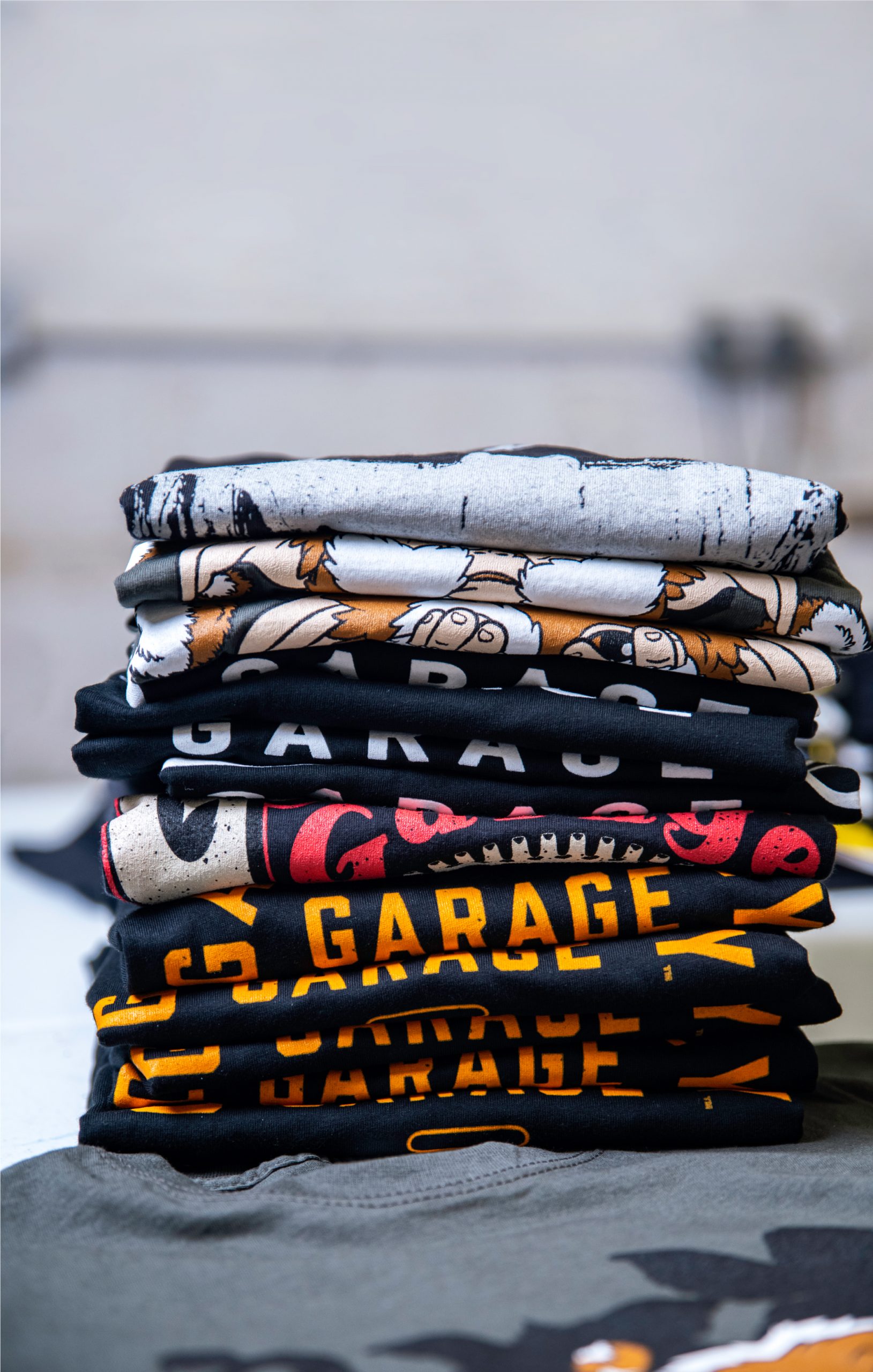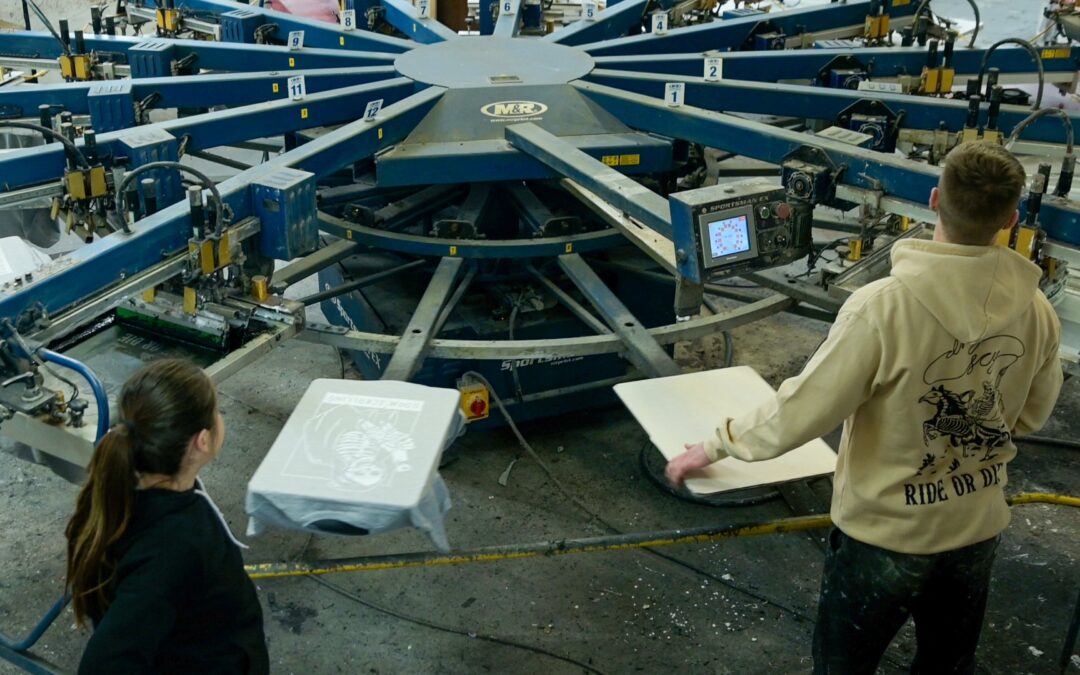Screen printing stands tall as a traditional yet adaptable method praised for its versatility, efficiency, and high quality. It’s successful in wholesale fashion, merchandise, custom promotional wear and uniforms. Let’s go back to the basics of this technique, the distinctive benefits, and more considerations for sustainability over the years.
Understanding Screen Printing
Screen Printing involves the process of transferring ink onto fabric through a mesh screen, with each colour applied separately, especially in flat/flatbed screen printing. This method is great for precision and vibrancy, making it a preferred choice for striking photographic printed designs and bold graphics. Its versatility extends to blank garments that can be used too, from t-shirts and hoodies to tote bags and Hi-Vis vests, catering to diverse customers across various industries.
High Density Printing and Fast Turnaround:
One of the standout features of screen printing is its ability to achieve high-density prints. This attribute lends garments a premium feel, enhancing their aesthetic appeal and perceived value. Moreover, screen printing boasts remarkable speed, making it ideal for bulk orders with tight deadlines. The efficient workflow from automated machinery ensures swift production without compromising on quality, catering to the demands of fast-paced industries like fashion and promotional merchandise.
Sustainability Considerations:
Amidst growing environmental consciousness, questions arise about the sustainability of the field and whether eco friendly screen printing is even possible. While it undeniably consumes resources much like most industrial practices, the longevity of screen-printed garments reduces the need for frequent replacements, keeping products in the cycle rather than adding to it. At our warehouse, we aim to keep sustainability at the forefront of working practice wherever possible, from recycling our misprints to donating overstock to charity. Embracing ethical sourcing practices and optimising production processes helps us to align with the evolving expectations of conscientious consumers, as well as our core values as a supplier.

How we work as screen printers in Leicester
Whilst we also have a plethora of other services, screen printing has and always will be at our core and our most popular service for clients. Here’s an idea of how our screen printing process works for a typical bulk order:
1. Preparing the Artwork
The process begins with the creation or preparation of the artwork files. This artwork is typically designed using graphic design software and must be formatted to match the print method.
2. Creating the Screen
The design is transferred onto a mesh screen using a light-sensitive emulsion. This involves coating the screen with the emulsion, allowing it to dry, and then exposing it to UV light through a film positive of the artwork. The UV light hardens the emulsion in areas where the design is present, making a stencil on the screen. Here at Teesh, we aim to reuse our frames where possible.
3. Setting Up the Printing Press
The prepared screens are then mounted onto the printing press, which consists of a flatbed table or board where the substrate will be placed, as well as a series of printing stations corresponding to each colour in the design. The number of stations can vary depending on the complexity of the design. Our maximum colour count for screen printing is 9 colours, so 9 screens and ‘stations’.
4. Loading the Substrate
The substrate, whether it’s a t-shirt, hoodie, or another material, is then loaded onto the flatbed table of the printing press. It is positioned precisely to ensure accurate printing of the design.
5. Registration and Alignment
Registration marks on the substrate and the screen are used to align each colour in the design accurately. This ensures that each colour is printed in the correct position relative to the others, resulting in a sharp and well-defined image and avoiding prints being out of line or blurry.
6. Ink Preparation
The ink colours needed for the design are matched according to the specifications, mixed and prepared for printing. Automated flatbed screen printing presses, including ours, often feature ink systems that can precisely control the amount of ink deposited onto the substrate, ensuring consistent colour saturation and print quality.
7. Printing Process:
Once everything is set up and aligned, the printing process begins. The flatbed table moves the substrate under each screen in sequence, while squeegees or flood bars apply ink to the screens, transferring the design onto the substrate. This process repeats for each colour in the design, with the substrate passing through each printing station.
8. Curing the Ink
After the final colour has been applied on the carousel, the printed substrate is typically passed through a curing oven or dryer. This cures the ink, bonding it to the substrate and ensuring durability and wash-fastness. We also flash dry our products to ensure as much durability as possible.
9. Inspection and Finishing
Once the printing and curing processes are complete, the printed substrates are inspected for quality assurance. Any defects or imperfections are addressed, and the finished products may undergo additional finishing processes. This includes folding, swing-tagging, or packaging before being shipped to customers.

As we navigate the dynamic landscape of textile printing, screen printing continues to shine as an enduring symbol of craftsmanship and innovation, weaving its vibrant threads into the fabric of contemporary fashion and merchandise.


Recent Comments